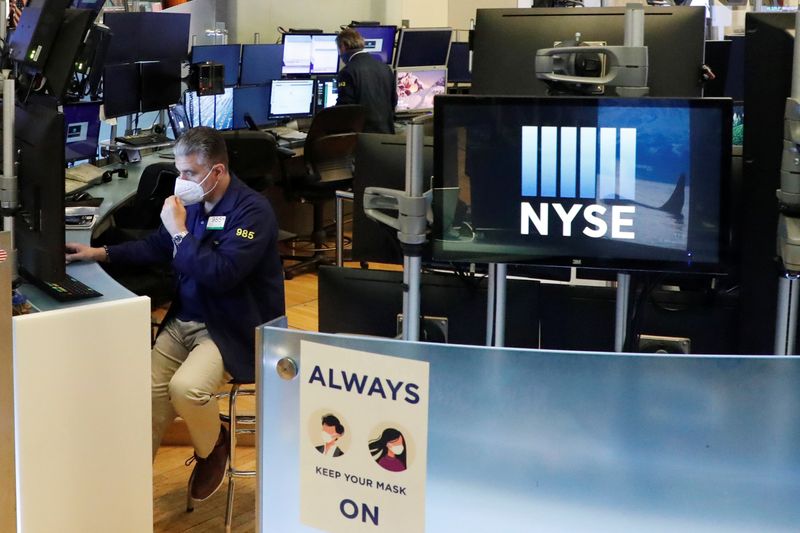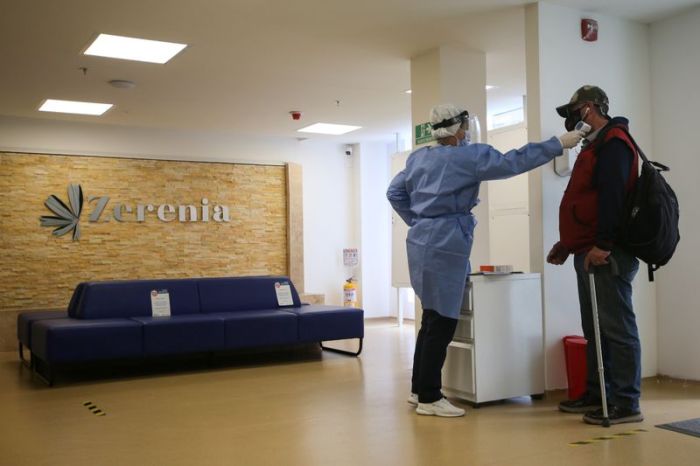(Reuters) – Wall Street ended higher after a choppy session on Tuesday, lifted by Apple and energy stocks but limited by declines in AIG and Microsoft while investors awaited more U.S. government stimulus to fight economic fallout from the COVID-19 pandemic.
Apple <AAPL.O> climbed 0.7%, up for a fifth straight session as investors cheered the iPhone maker’s blowout quarterly report last week. The Silicon Valley heavyweight is around $120 billion away from becoming the first U.S. publicly listed company with a stock market value of $2 trillion.
The S&P 500 energy index <.SPNY> jumped 2.45% and was the strongest performer among 11 sectors, while healthcare declined <.SPXHC>.
Ralph Lauren Corp <RL.N> dropped 4.4% to its lowest since May after quarterly revenue plunged due to coronavirus-related store closures and a slowdown in global demand for luxury goods.
American International Group Inc <AIG.N> tumbled 7.5% after its quarterly adjusted profit slumped.
Notwithstanding those two reports, about 83% of the 352 companies in the S&P 500 that have reported quarterly results so far have beaten estimates for earnings, according to IBES Refinitiv data.
“Investors are still comfortable that the trajectory of earnings is on the right path and the 2021 outlook has remained intact. All that helps support the market at these levels,” said Lindsey Bell, chief investment strategist at Ally Invest.
“But there is an underlying level of uncertainty leading to a bit of caution,” Bell added.
Investors are awaiting a major new coronavirus-aid bill, with Senate Democratic Leader Chuck Schumer saying talks with the White House were moving in the “right direction.”
A rally in tech-related stocks and trillions of dollars in monetary and fiscal stimulus have lifted the S&P 500 to within about 3% of February’s record high.
“I do not expect U.S. equities to revisit the March lows,” Mohamed A. El-Erian, chief economic adviser at Allianz SE, told the Reuters Global Markets Forum chat room.
“I suspect the next big correction will likely be one triggered by corporate defaults and other capital impairment events that central banks cannot shield against,” he said.
Microsoft Corp <MSFT.O>, which is looking to buy short-video app TikTok’s U.S. operations, fell 1.5%.
White House officials could not say how the U.S. government would receive a portion of the proceeds from any sale of TikTok’s U.S. operations, one day after President Donald Trump called for a cut of the money.
The Dow Jones Industrial Average <.DJI> rose 0.62% to end at 26,828.47 points, while the S&P 500 <.SPX> gained 0.36% to 3,306.51.
The Nasdaq Composite <.IXIC> climbed 0.35% to 10,941.17.
Evergy Inc <EVRG.N> slumped nearly 12% after two sources said the board of the Midwest utility planed to remain independent as bids solicited from prospective merger partners did not offer sufficient value.
Take-Two Interactive Software Inc <TTWO.O> rose nearly 6% after it raised its annual adjusted sales forecast on demand for its videogame franchises “Grand Theft Auto” and “NBA 2K”.
Walt Disney Co <DIS.N> rose 4% in extended trade after the company reported a rare quarterly loss, even as the coronavirus crisis helped its streaming services gain subscribers.
Advancing issues outnumbered declining ones on the NYSE by a 1.98-to-1 ratio; on Nasdaq, a 1.55-to-1 ratio favored advancers.
The S&P 500 posted 26 new 52-week highs and no new lows; the Nasdaq Composite recorded 129 new highs and 10 new lows.
About 9.7 billion shares changed hands in U.S. exchanges, compared with a 10.4 billion daily average over the last 20 sessions.
(Reporting by Sagarika Jaisinghani and Medha Singh in Bengaluru; editing by Uttaresh.V and Tom Brown)























